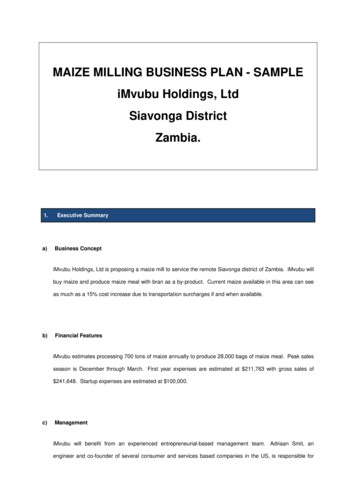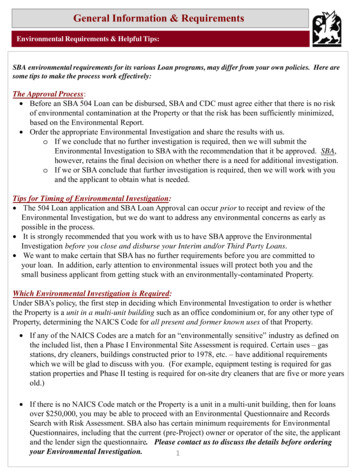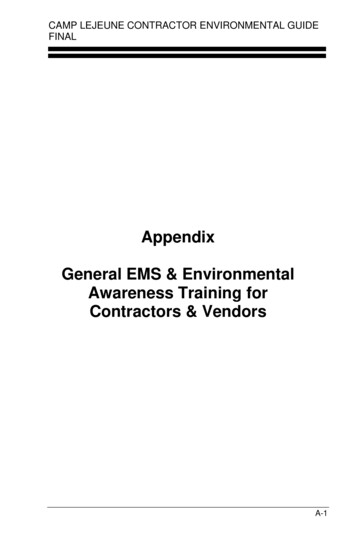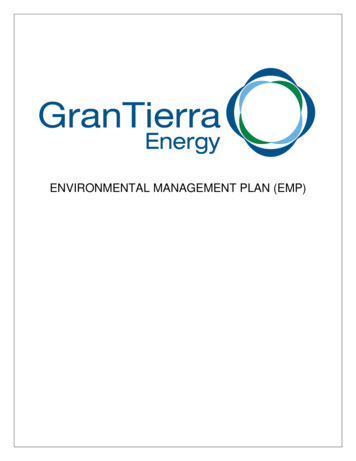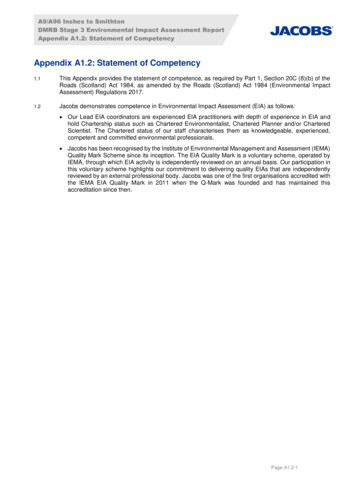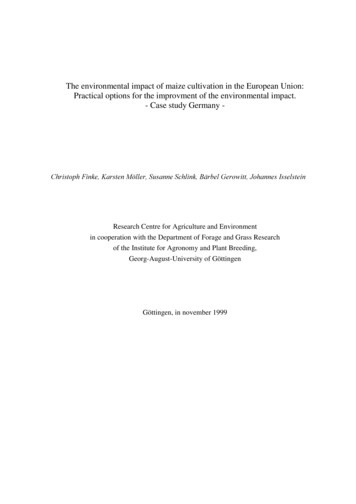
Transcription
The environmental impact of maize cultivation in the European Union:Practical options for the improvment of the environmental impact.- Case study Germany -&KULVWRSK )LQNH .DUVWHQ 0 OOHU 6XVDQQH 6FKOLQN %lUEHO *HURZLWW -RKDQQHV ,VVHOVWHLQResearch Centre for Agriculture and Environmentin cooperation with the Department of Forage and Grass Researchof the Institute for Agronomy and Plant Breeding,Georg-August-University of GöttingenGöttingen, in november 1999
Environmental impact of maize cultivation: case study Germany1&RQWHQWV &8/7,9 7,21 1' 87,/, 7,21 2) 0 , ( ,1 *(50 1 87,/, 7,21 BBBBBBBBBBBBBBB '(9(/230(17 2) 7 ( 0 , ( &5( *( BBBBBBBBBBBBBBBBBBBBBBBBBBBBBBBBBBBBBBBBBB ) &7256 )520 1 23(5 7,21 / 9,(: BBBBBBBBBBBBBBBBBBBBBBBBBBBBBBBBBBBBBBBBBBB *52120 % 6(6 2) 7 ( 0 , ( &8/7,9 7,21 BBBBBBBBBBBBBBBBBBBBBBBBBBBBBBBBBBBB )(57,/, 7,21 1' 3/ 17 3527(&7,21 ,1 0 , ( &8/7,9 7,21 BBBBBBBBBBBBBBBBBBBBB & 6( 678',(6 2) &8/7,9 7,21 2) 0 , ( ,1 :(6(5 (06 '(6&5,37,21 2) :(6(5 (06 BBBBBBBBBBBBBBBBBBBBBBBBBBBBBBBBBBBBBBBBBBBBBBBBBB / 1' 86(' )25 7 ( &8/7,9 7,21 2) 0 , ( ,1 :(6(5 (06 BBBBBBBBBBBBBBBBBBBBBBBB ,(/' 2) 0 , ( BBBBBBBBBBB /,9(672&. 352'8&7,21 1' &255(6321',1* 0 185( 48 17,7,(6 ,1 7 ( 585 /',675,&76 BBBBBBBBBBBBBBBB ())(&76 21 7 ( (19,5210(17 1' 92,' 1&( 675 7(*,(6BBBBBBBBBBBBBBBBBBBBBBB (19,5210(17 // &203 7,%/( &8/7,9 7,21 2) 0 , ( 0( 685(6 )25 1 (19,5210(17 // &203 7,%/( &8/7,9 7,21 2) 0 , (BBBBBBBBBB ())(&7,9(1(66 :,7 &216,'(5 7,21 2) (19,5210(17 / *2 /6 BBBBBBBBBBBBBBBBBB 23(5 7,21 / 1' 6758&785 / 5(48(676 BBBBBBBBBBBBBBBBBBBBBBBBBBBBBBBBBBBBBB (; 03/(6 2) 35 &7,& / ,03/(0(17 7,21 BBBBBBBBBBBBBBBBBBBBBBBBBBBBBBBBBBBBB )8785( '(9(/230(176 BBBB 6800 5 /,7(5 785(
Environmental impact of maize cultivation: case study Germany2 &XOWLYDWLRQ DQG XWLOL]DWLRQ RI PDL]H LQ *HUPDQ\1.1 UtilizationThe cultivation of Maize (]HD PD\V L.) in Germany is undertaken primarily to produce feedfor cows, pigs and poultry (maize for silage including green-maize, grain maize, corn cobmix, maize coarse meal with husks). As well as being used for producing sugar, grain is alsoused by the food industry to produce maize-meal-products, snacks, cornflakes etc., and inpharmaceutical processes. As a renewable raw material, maize starch is used in themanufacture of paper and cardboard (it is an important additive in wastepaper processing).New packing and impact protection materials are produced in new extraction mouldingprocedures from maize-semolina. Sugar-maize, normally marketed directly as whole earmaize, is finding wider markets (GERMAN MAIZE-COMMITTEE E.V. 1999, FEDERALMINISTRY OF AGRICULTURE 1995, CHAMBER OF AGRICULTURE HANNOVER1995).How the maize will be used determines the procedure of the maize cultivation. In Germany,maize is grown as grain maize, ear maize or maize for silage. Grain maize: The ripe grainsare harvested and used as feed or industrially processed. Ear maize becomes corn-cob-mix(CCM) or coarse maize meal with husks (used exclusively for forage) and is normally not asripe because harvesting begins earlier. Parts of the maize ear as well as the huskssurrounding the maize ear are harvested. They are crushed and preserved in a humidenvironment and used as a high energy forage. Silage maize is harvested as a whole plant,chopped into small pieces and preserved as basic forage even if the maize grains are not yetquite ripe.In Germany the area cultivated with maize amounted to 1.58 million ha in 1998 (GERMANMAIZE-COMMITTEE E.V. 1999). The largest maize-cultivating federal states of Germanyare Bavaria with approximately 400,000 ha and Lower Saxony with almost 300,000 ha,followed by North Rhine-Westphalia, Baden-Württemberg and Brandenburg (Figure 1).In Germany, 78% of the maize-cultivated acreage is maize for silage, 16% is grain maizeand 6% is corn cob mix (Figure 2). The acreage of maize for silage includes the relativelysmall arable lands used for maize coarse meal with husks and green-maize which is usedonly as fresh feed. It can be seen that there is a strong concentration of silage maizecultivation in the northwest and southern parts of Germany because many intensive fatteningbull farms, partially interconnected with dairy farming, are located in these regions (NorthWest-Germany and South-East-Bavaria). This leads to a high amount of semi-liquid manure.The semi-liquid manure can easily be spread on land with maize-cultivation because themaize tolerates an excess fertilization with nitrogen without yield loss.
Environmental impact of maize cultivation: case study Germany36FKOHVZLJ ROVWHLQ75.834 ha13%0HFNOHQEXUJ :HVWHUQ 3RPHUDQLD86.089 ha 8%/RZHU 6D[RQ\293.848 ha16%Berlin6D[RQ\ QKDOW1RUWK 5KLQH :HVWIDOLD77.317 ha8%216.894 ha20% HVVH3DODWLQDWH116.750 ha11%6D[RQ\7KXULQJLD5KLQHODQG %UDQGHQEXUJ33.385 ha7%52.681 ha8%74.530 ha8%20.348 ha5%6DDUODQG3.182 ha8%%DYDULD%DGHQ : UWWHPEHUJ392.583 ha18%131.998 ha15%maize-cultivated area (total):1.576.159 ha 13% of the arable land)LJXUH UDEOH ODQG LQ WKH IHGHUDO VWDWHV RI *HUPDQ\ DQG WKH SHUFHQWDJH XVHG IRUPDL]H SURGXFWLRQ LQ (source: GERMAN MAIZE-COMMITTEE E.V. 1999)Grain maize has the highest demand for warmth of all maize. This is why there is aconcentration of maize in Southern Germany, i.e. in the Rhine-valley (Baden-Württemberg)and in the main and lower Rott valley (Bavaria) as well as near Passau (Bavaria), primarilyin market-fruit-farms. Early and middle-early varieties of maize grow also in climaticallymore unfavourable border-situations of the low mountain regions and in the lowlands ofNorth-West-Germany. Here, the dominant areas of cultivation are on the intensive livestockfarms of Lower Saxony (Südoldenburg) and North Rhine-Westphalia (Westphalia-Lippe) –mainly on farms with livestock which have a supply of manure.
Environmental impact of maize cultivation: case study GermanyBavaria4304845Lower-Saxony224832North enburgCorn-Cob-Mix107085Mecklenburg-West. Pom.84145Saxony-AnhaltGrain Maize67214Schleswig-HolsteinMaize for Silage75604(in numbers)Saxony66907Thuringia48140Germany total*therefrom Maize for SilageGrain MaizeCorn-Cob-MixHesse 2659915735Rhineland-Palatinate* incl. Berlin, Bremen, Hamburg3102Saarland0 1.576.159 ha 1.235.130 ha 251.106 ha 89.923 50000DFUHDJH LQ KD )LJXUH 0DL]H FXOWLYDWLRQ LQ WKH IHGHUDO VWDWHV RI *HUPDQ\ VXEGLYLGHG LQWR WKHXWLOL]DWLRQ IRUPV VLODJH PDL]H JUDLQ PDL]H DQG FRUQ FRE PL[ (source: GERMANMAIZE-COMMITTEE E.V. 1999).1.2 Development of the maize acreageSince the mid-1960’s, the cultivation of maize had increased substantially in both parts ofGermany (Figure 3). Across the whole of Germany maize is now grown on 13% of thearable land. The main factor which has enabled this increase is the development of newstrains of maize which will grow in cooler areas. The development of Triazin, e.g. Atrazin,for weed control, improvements in harvesting and preservation technologies and in seedingtechniques (e.g. single grain seeds), have all supported this increase.In terms of acerage, the expansion of maize for silage acreage has already reached its peak inthe former FRG in 1986. Previously grown labour-intensive forage crops (fodder-beets,grass and clover-grass, lucerne) were substituted with maize for silage. In 1992, 73% of theacreage of forage crops in Germany were sown with maize for silage. This share hasremained constant since then.
Environmental impact of maize cultivation: case study Germany5694 599Maize for SilageGrain 9911990181 0011985118 819198096 061197599 4971970196549 8866 249196046898679819550472166787100000195020000026 821100 143300000227 4524000001996289 346500000307 115430 300600000190 575DFUHDJH LQ KD861 640900000879 4991000000893 767931 557)5* H[FHSW WKH QHZ IHGHUDO VWDWHV1999 preliminary)LJXUH 'HYHORSPHQW RI PDL]H LQ WHUPV RI DUHD RI ODQG FXOWLYDWHG KD LQ WKH )5*H[FHSW WKH QHZ IHGHUDO VWDWHV IURP IRU VLODJH PDL]H DQG JUDLQ PDL]H LQFOXGLQJFRUQ FRE PL[ (source: STATISTICAL FEDERAL-OFFICE 1999)*'5 QHZ IHGHUDO VWDWHV1000000900000Maize for SilageGrain Maize/CCM800000258470300000373 490372 289471 654360 484400000364 613500000336 855600000438730DFUHDJH LQ KD700000199919981997199633 91435 7181995199419931992199199419902 868198593019805 19502000001999 preliminary)LJXUH 'HYHORSPHQW RI PDL]H LQ WHUPV RI DUHD RI ODQG FXOWLYDWHG KD LQ WKH *'5DQG WKH QHZ IHGHUDO VWDWHV IURP IRU VLODJH PDL]H DQG JUDLQ PDL]H LQFOXGLQJ FRUQFRE PL[ (source: STATISTICAL FEDERAL-OFFICE 1999)
Environmental impact of maize cultivation: case study Germany6Because of the more favourable weather conditions in the south, Southern Germanyexpanded its maize cultivation before the northern areas. In the former GDR, as early as the1970s, more than 300.000 ha maize was grown for forage-production (Figure 4).Today the new federal states produce 30% of the total silage maize and 10% of the grainmaize in Germany. With the change in production-systems of the former GDR and thereduction of livestock husbandry, the land area used for silage maize has fluctuated over thelast few years.Since 1996, the acreage used for maize for silage has decreased in both the new and oldfederal states. The reduced demand for beef (BSE-crisis) has had an effect on livestockproduction and consequently on forage production.1.3 Factors from an operational viewGrain maize is an important cash crop for farms without livestock - above all in Bavaria andBaden-Württemberg. In the typical cultivation areas of Mid and Southern Bavaria (the ruraldistricts of Erding, Rottal-Inn, Landshut) and the area enclosed in the Rhine valley up to60% of arable land is cultivated with maize (ZSCHEISCHLER 1990).In the North-West-regions of Germany with high levels of livestock, maize for silage andCCM are essential components of the feed-rations for cows and pigs. Grain maize is used forpoultry forage. In the district of Weser-Ems more than 30% of the arable land is cultivatedwith maize (CHAMBER OF AGRICULTURE WESER-EMS 1998a). In intensive livestockfarms, ear maize is grown as an alternative to grain maize, relieving the farmers of the highcosts of drying. This particular harvest and preservation technique also makes the productionof profitable forage with maize possible in the cooler regions of Germany.The cultivation of maize for silage plays a large role in forage-growing farms. Maize forsilage is a valuable, high energy, basic forage and cattle seem to enjoy it so that forage intakeis high. Protein rich basic forage rations (with grass silage) in grassland-farms can becomplemented with maize-silage. The maize-silage increases the calorific value of the forageand ruminants then use the proteins more effectively. Also the quality of the basic forageitself increases and a better basic forage leads to higher livestock productivity and thepurchase of forage concentrates can be reduced. These benefits are additional to those ofhigher productivity per acre and the improved nutrient acquisition (particularly for farmyardmanure). The operational nitrogen balance of a farm can be improved by cultivating maize.In organic agriculture, maize for silage-cultivation still plays a minor role although theproductivity and the energy-content of the forage plant are topics of interest (GERMEIER1997). Since 1990, the arable land growing organic maize for silage amounts to less than 2%of all the land used for organic agriculture. Over the same time period, conventional farmsgrew maize for silage on 13% of their fields (FEDERAL GOVERNMENT 1990-1998). data for the maize-cultivationIn order to give an overview of the status of maize production in agriculture the standardmarginal contributions are presented in Table 1. It should be remembered that a subsidy of443 to 797 DM/ha (1999) is paid for maize, depending on the federal state and region.7DEOH YHUDJH JURVV PDUJLQDO FRQWULEXWLRQ IRU WKH PDLQ PDL]H FXOWLYDWLRQSURFHGXUHV LQ *HUPDQ\ LQ (in DM/ha without consideration of the subsidy)
Environmental impact of maize cultivation: case study GermanyXWLOL]DWLRQ IRUPFURS \LHOGJURVV \LHOGtonnes/ha without subsidy totalJUDLQ PDL]H 6RXWK )5*PDL]H IRU VLODJH 1RUWK )5*FRUQ FRE PL[ 1RUWK )5*7YDULDEOH FRVWVpart seedes fertilizer weed control machines other AGMC94512,5216017302250* 17162000** 163627428126927242128027026925051561576739913070 7,56,5180014951301252602392711634274206050 for comparisonZLQWHU ZKHDW 6RXWK )5*WULWLFDOH 1RUWK )5*1148997assumtion: * value of maize silage 50 DM/t x 45 2250 DM** value of corn cob mix 160 DM/t x 12,5 2000 DMAGMC average gross marginal contributionsources: Chamber of Agriculture Hannover 1999, KTBL average gross marginal contribution 1997/981.4 Agronomy bases of the maize-cultivationMaize is very self-sufficient and therefore it can be grown as a monoculture. Its demand forwarmth during germination and early development (frost-sensitivity) leads to a late sowingfrom the end of April until mid-May, depending on the region. The 311 maize varietieswhich are officially recognised in Germany (1999) are adapted to local climatic conditions.7DEOH &ODVVLILFDWLRQ RI 0DL]H YDULHWLHV LQ 0DWXULW\ (source: GERMAN MAIZECOMMITTEE E.V. 1999)0DWXULW\ JURXS5LSHQHVV QXPEHUDYHUDJH GDLO\ WHPSHUDWXUH0D\ 6HSWHPEHUearlymiddle-earlymiddle-latelateuntil 220230-250260-290300-35014,0-15,0 C15,0-15,5 C15,6-16,4 C16,5-17,4 C* Ripeness-number approximately corresponds to the FAO-numberThe maize hybrids are divided into maturity-groups, for both silage and grain use (Table 2).The ripeness number for silage is based on the ripening behaviour of the entire plant and theripeness number for grain only takes into account the maize ear.Maize grows, like potatoes and sugar beets, as a row-culture. Depending on the harvestingtechnology and its use, the distance between the rows is normally 75 cm and the populationdensity 9-13 plants/m2. If no mechanical weed control takes place, the distance between therows can be reduced to 30 cm. This increases the ability of the plants to exploit nutrients(CHAMBER OF AGRICULTURE WESER-EMS 1999), although appropriate sowingtechniques and a row-independent harvesting technology must be used. Harvesting isnormally contacted out.The cultivation of maize causes soil erosion in some regions of Germany. This occursmainly on hillside land with easily eroded soil material. The risk of soil erosion is greater inspring because maize is grown in rows and covers the ground late (LÜTKE ENTRUP &ZERHUSEN 1992). To protect the soil and to redevelop old neglected deposits of toxicwaste the Federal Soil Protection Law of 1998 (SOIL PROTECTION LAW 1998) shouldreduce erosion where it is avoidable with the help of suitable measures (FEDERALMINISTRY OF AGRICULTURE 1999).Despite the relatively high water use efficiency (3,3 g Dry Matter/ 1 kg water), the waterdemand of maize is considerably on the basis of the high output. In order to avoid yieldlosses, the water-demand should be especially catered for during June and July. In the classicdry areas of East and Central Germany as well as at Upper Rhine valley and in the water
Environmental impact of maize cultivation: case study Germany8catchment area of the Eifel, considerable shortfalls can occur in the water supply of theplants. In order to supply the high water need some farmers irrigate their maize.Maize is harvested in the autumn and late-autumn (September-December). Large, heavyharvesters to harvest and chop the maize for silage are used. Fair-weather is required forharvesting which is different than, for example, sugar beet. Over the last few years "staygreen" varieties of maize for silage have been used which extend the time for an optimalharvest and a high silage quality is possible and soil compaction can be avoided. Primarilyfarmers grow winter wheat which is adopted to late sowing as the following crop in arotation, if maize is not grown again (LÜTKE ENTRUP & ZERHUSEN 1992).1.5 Fertilization and plant-protection in maize cultivation IHUWLOL]DWLRQThe European limit for nitrate in drinking water (EC-nitrate-guideline of 1991) was put intopractice in Germany in 1996. The German government implemented an ordinance for theprinciples of good technical practice for fertilization in agriculture (FERTILIZATIONORDINANCE 1996). This fertilization ordinance regulates the application of fertilizers,restricts times for the use of semi-liquid manure, compares nutrients and establishes a duty torecord fertilization for the first time on a national basis. It also lays down a maximumamount of manure which can be spread (maximum average content of 170 kg N/ha for eachagricultural enterprise). Concrete limits for mineral fertilizers, however, are not given in theordinance, nor are maximum levels of fertilization per acre for certain cultures (OSWALD1998). This ordinance is interpreted further by the individual governments of each federalstate.In contrast to other grain-types, maize has a period of especially intensive growth after aslow initial development. For this reason, plant-available nutrients (mainly phosphate) areplaced near the seedling during planting (underground fertilization). Maize is very effectiveat using mineralized nitrogen from manure because of its long vegetation time, which lastsuntil autumn (AUFHAMMER 1988).The following statements are based on official guidelines with respect to fertilization:1LWURJHQ:For an exact calculation of the N-fertilizer requirement, the mineral-nitrogencontent of the soil between the 6 and 8 leaf stage of the maize is measured. Only when themaize-plants are so far developed they can incorporate nutrients in considerablequantities. The difference between the measured nitrogen level and what is appropriateshould be made up with mineral and/or manure fertilizer. The appropriate level ofnitrogen is determined on a regional basis (180-200 kg N/ha) and depends on theexpected profits.3KRVSKRUXV: It promotes the initial development, bloom and fruit-formation as well asstarch-storage. Dependent on the variety of maize grown, 40 – 50 kg/ha of phosphorusper crop is removed and should be replaced by fertilization.3RWDVVLXP: Beside the positive influence on the water supply, potassium promotes thedevelopment of mass in the shooting phase and increases the steadiness of the maize.Also the resistance of the plant against illnesses and pests increases. Maize has a highpotassium requirement. The removal of potassium from the soil depends on the use of themaize and varies from 140 to 250 kg K/ha.0DJQHVLXP: The demand of maize for magnesium is comparatively low and is met bynormal fertilization with manure in livestock farms (grain maize removes 20 kg Mg/haand silage maize 40 kg Mg/ha).These figures do not necessarily reflect what happens in practice. It can be assumed thatmanure is used at high levels as well as other fertilizers. Maize tolerates a high level of
Environmental impact of maize cultivation: case study Germany9fertilizer and in intensive livestock farms large quantities of semi-liquid manure need to bedisposed of. SODQW SURWHFWLRQThe use of pesticides is regulated by the nationally applicable ’law to protect crops’, short:plant protection law (PLANT PROTECTION LAW 1998) which came into effect on 14.May 1998. In water protection areas some pesticides are forbidden (PLANTPROTECTION-APPLICATION-ORDINANCE 1997). Pesticides which are allowed todayfor the cultivation of maize are not yet included in the list of forbidden pesticides.Direct plant protection precautions for maize are, essentially, aimed at weed control. In theSouthern, and therefore warmer regions of Germany, the fight against the European cornborer (Ostrina nubilalis) is important. As a preventative measure, the harvest residuals arecrushed and deeply ploughed in. Two biological measures are available to combat the cornborer. The use of slip-wasps (Trichogramma) and the spraying of a bacillus thuringiensispreparation are practicable. Insecticides are less important. Fungicides are not applied duringthe cultivation of maize. Coating the seed to prevent the development of the fruit fly larvae(Oscinella frit) is standard practice. Maize does not compete well with weeds in its earlydevelopment stage and this has meant that there is an economic necessity to deal with them.&KHPLFDO ZHHG FRQWURO: After the discontinuation of Atrazin (application was prohibited inGermany from 1991) new herbicides and mixtures were developed. They are used beforesowing, before or after plant shooting. In some regions of Germany, herbicide-resistanceshave appeared with intensive maize cultivation. Some weeds are very difficult toeliminate. In the North of Germany: cock’s-foot grass ((FKLQRFKORD FUXV JDOOL), hairycrabgrass ('LJLWDULD VDQJXLQDOLV), and in South Germany: millets (6HWDULD JODXFD YLULGLV), fat hen (&KHQRSRGLXP DOEXP) and black nightshade (6RODQXP QLJUXP) areserious weeds.0HFKDQLFDO ZHHG FRQWURO: farmers can work between the rows with various types ofmechanical hoes. Up until harvesting the use of the blind-currycomb is also possible. InGermany, mechanical weed control is used only to a minor extent because agrochemicalsare cheaper.A combination of chemical and mechanical weed control can be implemented by bandspraying. This helps to reduce the use of pesticides, but only a few farmers use this technique(LÜTKE ENTRUP & ZERHUSEN 1992).
Environmental impact of maize cultivation: case study Germany10 &DVH VWXGLHV RI FXOWLYDWLRQ RI PDL]H LQ :HVHU (PVIn the state of Lower Saxony, the cultivation of maize has become very important over thelast few decades, particularly for forage-production. The land area used for silage maizeincreased up until the middle of the 1980s to 200,000 ha (figure 5). The breeding of earlymaize varieties and developments in harvesting technology have led to an increase in theland given over to maize since the beginning of the 1980s. The acreage of grassland, whichis very significant for the natural environment, water protection and for producing forage onthe farms, has continuously decreased over the last 30 years. Today maize is often cultivatedon former grassland. If wet periods frequently occur over the winter, maize can be sown latein comparison to other crops./RZHU 6D[RQ\ 1 400 0001 200 000DFUHDJH LQ KD1 000 000800 000Grain maize(CCM)Maize for Silage600 000Permanent Grassland400 000200 619741972197019680(1999 preliminary))LJXUH 'HYHORSPHQW RI WKH FXOWLYDWLRQ RI PDL]H DQG WKH DFUHDJH RI JUDVVODQG LQ/RZHU 6D[RQ\ (source: STATISTICAL FEDERAL-OFFICE 1998)In 1998, 60% of the total area used for the cultivation of maize in Lower Saxony was inWeser-Ems region, although it is only 31% of the farmland of Lower Saxony. Thishighlights the strong concentration of the maize in this region.2.1 Description of Weser-EmsThe Weser-Ems district is in the west of Lower Saxony and borders the Netherlands (figure6). It possesses an agricultural chamber of its own, based in Oldenburg. Weser-Ems includesthe towns of Delmenhorst, Emden, Oldenburg, Osnabruck and Wilhelmshaven and 12 otherrural districts (table 3 ).
Environmental impact of maize cultivation: case study Germany11)LJXUH /RFDWLRQ RI :HVHU (PV LQ *HUPDQ\ DQG LW V UXUDO GLVWULFWV climate - and soil circumstancesA moderate maritime climate prevails in Weser-Ems. The average precipitation is 810 mmper year. Inland, it rains between 650 and 700 mm per year. The average temperature is to8.5 C. From May until September, which is vital for the growing of maize, the averagetemperature is approximately 15 C. Conditions for the silage maize cultivation and CCM aregood. The production of grain maize is only possible with early maturing varieties. Anenergy-intensive drying of the maize-grains is normally necessary because the maize has awater content of 30-35%. Some farmers use propion-acid for a conservation.One finds the following soil circumstances in the Weser-Ems (figure 7): Marsh grounds ofdifferent types have been formed in the coastal-area from young sea sediments. Furtherinside of Weser-Ems on the post ice-age grounds, soil has been formed over pleistocenesands and old moraines. There are extensive moor areas nearby which transforms to meadowaround the wider river valleys. The grounds in the most southern part of the area havedeveloped from loess-sediments, although in Weser-Ems this area is small. Podzols, podzolbrown-earths, Podzol-Para-brown-earth and moors are among the frequent inland soil-types.
Environmental impact of maize cultivation: case study Germany12Soil-types are silt, clay and humus sands. The sandy soils have a relatively low mechanicalfiltering ability and middle to high water permeability. There is a relatively high potential forfertilizers and pesticides to be carried into the groundwater by rain.red:yellow:postCoastal-marshSandy soil from theice-agegreen: humus-moor soilbrown: brown and parabrownearth on loess sedimentssource: FEDERAL-OFFICE FOR SOILRESEARCH OF LOWER SAXONY)LJXUH 6RLO PDS RI :HVHU (PV structure of agricultureDairy farms are mainly in the coastal rural districts of Aurich, Wittmund and Wesermarsch,where there is a high proportion of grassland. In these forage-growing farms, the little arableland is frequently used every year to produce silage maize. The share of maize is low inrelation to the agricultural land (incl. grassland), but it is high in relation to the arable land(table 3). In the rural districts Vechta, Oldenburg, Cloppenburg and Emsland grassland isless important. Here, intensive livestock farms with pig and/or poultry have been established.
Environmental impact of maize cultivation: case study Germany137DEOH 6L]HV RI ILHOG DQG JUDVVODQGV DQG SURSRUWLRQ RI ODQG XQGHU PDL]H LQ WKHUXUDO GLVWULFWV RI :HVHU (PV (source: LOWER SAXONY DEPARTMENT FORSTATISTICS 1999)rural districtsfarmland therefromin hagrasslandin hatherefrommaize-sharearable landof the arablein hain % of %24%total943.708400.176543.53232%58%The size of farms in the Weser-Ems region is lower then the average for Lower Saxony.Most farms have a size of 30-50 ha agricultural land (table 4). There is a below averagenumber of farms with more than 50 ha of land in the Weser-Ems region. This is reflected bythe importance of livestock production which is less dependent on the size of the farms.7DEOH JULFXOWXUDO EXVLQHVVHV JURXSHG E\ TXDQWLW\ RI WKH DJULFXOWXUDO XVHG ODQG (source: STATISTICAL FEDERAL-DEPARTMENT)sizefrom. to under. ha:HVHU (PVfarmsnumber/RZHU 6D[RQ\farmssharein %numbersharein %1-23.83611,08.88711,22-54.55913,110.46813,25 - 103.97711,48.50610,7
Environmental impact of maize cultivation: case study Germany1410 - 152.5867,45.5046,915 - 202.2076,34.7105,920 - 304.41912,78.30410,430 - 507.21520,713.79717,450 - 2100100 and moretotal2.2 Land used for the cultivation of maize in Weser-EmsWeser-Ems23,9%5,3%2,7%Rural ck18,5%Vechta17,8%Cloppenburg4,5%5,5%2,9%Grain Maize(% arable land)5,0%3,4%12,9%Maize for Silage(% arable land)2,5%27,6%Corn Cob Mix(% arable 50%60%)LJXUH UDEOH /DQG XVHG IRU WKH FXOWLYDWLRQ RI PDL]H LQ WKH :HVHU (PV LQ VXEGLYLGHG E\ XWLOL]DWLRQ IRUP (Source: LOWER SAXONY DEPARTMENT FORSTATISTICS 1999)Figure 8 shows that the predominant regions for maize as grain maize and CCM are Vechta,Cloppenburg, Emsland, Osnabruck and Bentheim where these crops are grown to aconsiderable extent. These rural districts show with 70-85% the highest proportion ofagricultural land which is arable (compare table 3). In the grassland-regions (rural coastaldistricts), silage maize is grown almost exclusively as a high energy basic forage which isimportant for cattle. The high quality of silage maize leads to its extended use. On heavymarshes, timely sowing is not always possible and the harvest is difficult. Higherprecipitations (up to 900 mm) and lower summer-temperatures in the coastal-situationsretard the ripening of the maize.2.3 Yield of maize data from survey of the Lower Saxony department for statistics
Environmental impact of maize cultivation: case study Germany15Figure 9 shows the average yields achieved with silage and grain maize for 1994-98 in therural districts of Weser-Ems.Grain maizet/ha dry material (14% water)Maize for Silaget/ha green materialGrain Maize incl. CCM 1994-98845Maize for Silage 1994-98Lower SaxonyWese
Environmental impact of maize cultivation: case study Germany 2 &XOWLYDWLRQDQGXWLOL]DWLRQRIPDL]HLQ*HUPDQ\ 1.1 Utilization The cultivation of Maize (]HDPD\V L.) in Germany is undertaken primarily to produce feed for cows, pigs and poultry (maize for silage including green-maize, grain maiz
